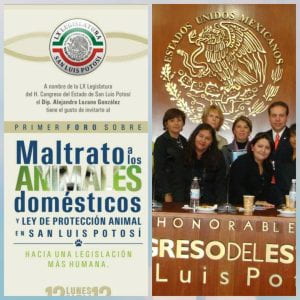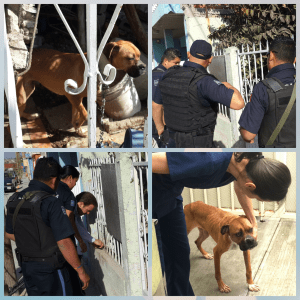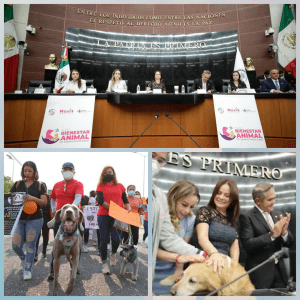The relationship between Animal Cruelty and Domestic Violence
Changing the social and legislative perspective towards animal abuse
What do serial killers such as Charles Manson, Ted Bundy, Charles Cullen (the “New Jersey Nurse”), Jeffrey Dahmer (the “Milwaukee Cannibal”), David Berkowitz, and Alberto DeSalvo (“the Boston Strangler”) have in common besides the number of their murders? All of them began their cruel and violent behavior with animals.
According to Mexico’s Institute of National Statistics and Geography, the country ranks third in the world in animal abuse, and first in Latin America. Other data from this study include: 18 million dogs in Mexico that live on the street, one out of seven suffers from abuse; 69.8% of Mexican households have some type of pet, and more than 600,000 pets die from abuse. Cut, burned, buried alive, poisoned, dragged, chained up without water or food, thrown into garbage dumps, or raped by their owners. These are some forms of animal cruelty in Mexico. Terrifying, but real.

Source: Igualdad Animal México, Foro Jurídico & El Sol de Orizaba
Mexico is among the five most violent countries in the world, according to several reports. In 2021, Domestic violence in Mexico City increased by 46.25% compared to 2020, according to the NGO Citizen Observatory.
It would be wrong and irresponsible of me to suggest and attribute the domestic violence in Mexico to animal abuse, but there is a correlation. I believe that early detection, education, and prohibition of violent conduct towards animals can stop a pattern of violence that will continue with human beings.
In 2012, as a legislator of the State of San Luis Potosí in Mexico I had the honor of promoting one of the country’s first state legislation bills that criminalized animal abuse. Despite the invaluable support of several people involved in the issue, the initiative provoked criticisms that could be summarized in the following question: why do you spend time protecting dogs when there are so many other social problems such as insecurity and violence?
The premise was clear: those who are violent with animals will be violent with partners, children and others.
This premise helped me to focus on the relationship between animal cruelty and violence toward humans instead of explaining the legislative terms of the initiative. To show evidence of this strong relationship between animal cruelty and violence toward humans, I found several studies from psychiatrists, psychologists, academics, and the FBI that confirmed this link (such as “The abuse of animals and domestic violence: A national survey of shelters for women who are battered,” by Wood, S. David, Weber, V. Claudia, Ascione, Frank, 1997).
Having demonstrated that animal abuse is one of the clearest preludes to domestic violence, helped me to the unanimous approval of the bill and place animal protection on the public agenda.

Source: Mariott – The Economist Namibia
Although in 1978 Mexico committed to compliance with the Universal Declaration of Animal Rights and in 1988 enacted the provisions on animal issues in its federal legislation, talking about animal protection ten years ago was a subject of mockery and underestimation for many people who assumed that the issue depended entirely on whether you like dogs or not.
As a congressman, one of the main issues I would work for would be to achieve an animal protection law. I knew this initiative, like many others, would bring me some criticism. I remember that when I announced this initiative together with others such as the elimination of the vehicle tax, the reduction of the Christmas bonus for members of Congress to be used for academic scholarships, and the creation of a special commission against municipal corruption, a veteran politician advised me, “The key in politics is to act like you work a lot but do nothing, so you don´t expose yourself and you will never be criticized.” In his mediocre mentality, I found one of the reasons why Mexico is one of the most corrupt and violent countries, with half of its population living in poverty.
I presented the initiative thinking that it would take about two months for its approval.
As with every initiative I presented in Congress, I explain the initiative to the members of the legislative commissions where it had been submitted, I organized forums with animal protection associations, activists, authorities, academics, and citizens in general. Likewise, I visited Chambers of Commerce, universities, and high schools.

Source: First Forum on Animal Abuse and the Animal Protection Law at the San Luis Potosí, State Congress. Alejandro Lozano photo archives
Despite the strong support for the initiative, the initiative began to stall for several reasons. First, the natural process of the legislative committees to analyze the initiative took longer than I thought, plus I felt that some colleagues had this unconscious bias of considering the animal issue as something less important. Second, many radical activists wanted that the initiative to include all animals such as bulls, roosters, chickens, cows, etc—not just pets. The scope to include all animals is endless and impossible to really and legally accomplish and the problem with making “all-or-nothing types of law” is that in the end, nothing gets done. And when unrealistic laws are approved by harmful populism, the famous law becomes…dead letter, and nothing is achieved either. Third, several citizens complained, saying “I did not vote for you to go around taking care of puppies” or “get to work on serious issues.” However, one complaint helped me formulate my main argument to promote my initiative: “Why do you spend time on animal protection when there are more important problems such as violence?” Precisely, that is one of the main reasons I´m doing it, I replied and asked him: Do you think that a person capable of raping a dog, burning it alive or mutilating it for fun, won´t dare to do the same with a person?” I had not seen it that way, he answered.
Animal abuse is the prelude to domestic violence. This was my main argument to achieve a greater consensus with my fellow members of Congress and above all, to change the mentality and attitude towards animal abuse in society. I had to demonstrate this argument with solid arguments. To do so, I used different research from psychiatrists, academics, specialists in the subject, and even the FBI, which demonstrated the dangerous relationship between animal abuse and domestic violence.
For instance, one study (“Childhood Cruelty to Animals Among Offenders and Non-Offenders” by Stephen R. Kellert and Alan R. Felthous, 1985), found that childhood cruelty to animals occurred much more among aggressive offenders than among non-aggressive offenders or non-delinquents.
In another article published in Child Abuse Review in 2004, Fiona Becker and Lesley French recognized a direct link between child abuse, animal cruelty, and domestic violence, saying that animal abuse is part of the abuse within the family, and pointing to the fact that child abuse and cruelty towards animals has influenced the legislative bodies in some countries to pass laws on animal cruelty.
In 2016, for the first time, the FBI began to include animal cruelty crimes in the same category as murder, rape, and arson. According to the FBI, the triad of 1) being abused as a child, 2) reacting by torturing animals, and 3) becoming violent toward humans is so well established that animal cruelty is used to identify potential suspects of violent crimes and as an indicator of potential future offenders. Another FBI investigation corroborates that most serial killers tortured animals as children.

Source: animalliberationfront.com
In May 2013, after eight months, the Animal Protection Law for Domestic Animals was unanimously approved, and San Luis Potosi became the third state in the country to criminalize the abuse of pets. I will always be grateful to many animal protection associations and professional activists who had been working on the subject for decades. Without their support, and that of thousands of citizens throughout the state it would not have been possible.
Although the law had been passed, the real work was about to begin. I spoke with the governor, all municipal presidents, the secretary of public security, the San Luis Potosí state attorney general, and the media owners for promotion, explanation of where and how to denounce, and application of the law. The authorities and society had to take this law seriously and see that it would be enforced. I filed complaints and went personally with the police to investigate several reports.

Alejandro Lozano accompanies the police to one of the first reports of animal abuse under the new law. | Source: Alejandro Lozano photo archives.
In recent years, Mexican society and authorities have become more conscious of the importance of the rights, care, and respect for animals. On the one hand, the Mexican Congress and most of the State Congresses have made progress in animal welfare laws. In 2014, Congress approved a reform in the General Wildlife Law. Currently, 28 states out of 32 in the country have legislation that criminalizes animal abuse. A few weeks ago, the Senate of the Republic held the “Animal Welfare Forum” to generate better legal instruments to advance the protection of animals. In addition, social networks have been a very helpful tool to raise awareness, and to witness, denounce and promote a culture of adoption, sterilization and, above all, respect. On the other hand, more and more Mexicans are aware that their pets are not objects but living beings that should be treated with humanity. Social networks have been a very helpful tool to denounce cases of animal abuse and also promote a culture of adoption, sterilization, and, above all, respect. Nevertheless, as the country ranked third in the world in animal cruelty, there is still a lot of work to be done.

Source: Senate of the Republic & El Heraldo de Chihuahua
Mexico’s alarming domestic and social violence has many roots but accepting that a significant part of it begins and is reinforced by cruelty to animals can help detect and stop this violence from continuing over time. The authorities at all levels of government, legislators, and society need to accept that animal cruelty has a direct relationship with human violence and therefore must be seen as another of the many important issues that we have to solve in Mexico.
La Relación entre Crueldad Animal y Violencia Doméstica
Cambiar la perspectiva social y legislativa del maltrato animal
Por Alejandro Lozano
¿Qué tienen en común asesinos seriales como Charles Manson, Ted Bundy, Charles Cullen (“el enfermero de Nueva Jersey”), Jeffrey Dahmer (“el Caníbal de Milwaukee”), David Berkowitz, y Alberto DeSalvo (“el estrangulador de Boston”) además del número de asesinatos? Todos ellos empezaron su crueldad y comportamiento violento con animales.
México ocupa el tercer lugar en maltrato animal en el mundo, y el primero en todo América Latina, según el Instituto Nacional de Estadística y Geografía. Otros datos que arroja el estudio son: 18 millones de perros que viven en la calle en el país, uno de cada siete sufre maltrato; el 69,8% de los hogares en México tiene algún tipo de mascota, y más de 600.000 mascotas y animales de la calle mueren por maltrato. Cortados, quemados, enterrados vivos, envenenados, arrastrados, encadenados sin agua ni comida, arrojados a basureros o violados por sus dueños. Estas son algunas formas de crueldad animal en México. Aterrador, pero real.

Source: Igualdad Animal México, Foro Jurídico & El Sol de Orizaba
México se encuentra entre los cinco países más violentos del mundo, de acuerdo con diferentes informes. En 2021, la violencia doméstica en la Ciudad de México subió 46,25% respecto al 2020, según la ONG Observatorio Ciudadano.
Sería equivocado e irresponsable de mi parte sugerir y atribuir la violencia doméstica que se vive en México se debe al maltrato animal, pero sí hay una relación. Estoy convencido que la detección temprana, la educación y la prohibición de conductas violentas hacia los animales puede detener un patrón de violencia que continuará con seres humanos.
En 2012, como diputado del estado de San Luis Potosí, México, tuve el honor de promover una de las primeras iniciativas de ley en el país que penalizaba el maltrato animal. A pesar del invaluable apoyo de muchas personas involucradas en el tema, la iniciativa provocó críticas que podría resumir con la siguiente pregunta: ¿por qué dedicas tiempo a defender perros cuando hay problemas graves como la inseguridad y la violencia?
La premisa era clara: quien es violento con un animal lo puede ser con su pareja, hijos y otras personas.
Esta conclusión me ayudó a que en lugar de dedicarme a explicar los términos legislativos de la iniciativa, me enfocara en la relación que existe entre la crueldad animal y la violencia hacia los humanos. Para demostrar esta fuerte relación encontré varios estudios de psiquiatras, psicólogos, académicos y del FBI que confirmaban este vínculo (como “El Maltrato Animal y la Violencia Doméstica: una encuesta nacional de albergues para mujeres maltratadas”, de Wood, S. David, Weber, V. Claudia, Ascione, Frank, 1997).
Haberme enfocado en la relación entre maltrato animal y violencia doméstica, logró la aprobación de ley en el Congreso, y posicionó de manera permanente el tema de protección animal en la agenda pública.

Source: Mariott – The Economist Namibia
Aunque en 1978 México se comprometió a cumplir con la Declaración Universal de los Derechos de los Animales y en 1988 promulgó las disposiciones en materia animal en su legislación federal, hablar de protección animal en México hace diez años era un tema de burla y si importancia para muchas personas que suponían que el tema dependía si te gustaban los perros o no.
Como diputado, uno de mis principales temas por el que trabajaría sería lograr una ley de protección animal. Sabía que esta iniciativa, como muchas otras, me acarrearía críticas. Recuerdo que en mi primer mes, cuando anuncié esta iniciativa junto a otras como la eliminación del impuesto de la tenencia vehicular, la reducción del aguinaldo de los diputados para destinarlo a becas educativas y la creación de una comisión especial contra la corrupción municipal, un político de la vieja guardia me aconsejó: “La clave en política es no hacer nada, pero actuar como si trabajaras mucho, así no te expones, no te desgastas y nadie te criticará.” En su mentalidad mediocre encontré una de las razones por las que México es uno de los países más corruptos y violentos, con la mitad de su población viviendo en la pobreza.
Presenté la iniciativa pensando que tardaría unos dos meses en ser aprobada.
Como en cada iniciativa que presenté en el Congreso, expliqué la iniciativa a los integrantes de las comisiones legislativas donde había sido turnada, organicé foros con asociaciones protectoras de animales, activistas, autoridades, académicos y ciudadanos en general. Asimismo, la expuse en Cámaras de Comercio, universidades y escuelas.

Source: First Forum on Animal Abuse and the Animal Protection Law at the San Luis Potosí, State Congress. Alejandro Lozano photo archives
A pesar del gran apoyo que la iniciativa obtuvo, la iniciativa se empezó a atorar por diferentes razones. En primer lugar, el proceso natural de las comisiones legislativas para analizar la iniciativa era más tardado de lo que creía, además sentía que algunos compañeros tenían este prejuicio inconsciente de considerar el tema animal como algo menos importante. En segundo lugar, muchos activistas más radicales querían que la iniciativa incluyera a todos los animales, como toros, gallos, gallinas, vacas, etcétera, y no sólo a los animales de compañía. El alcance de incluir a todos los animales es interminable e imposible de cumplir legal y realmente, y el problema de proponer leyes “todo o nada” es que no se avanza absolutamente nada. Y cuando se llegan aprobar leyes muy populares pero irreales, la famosa ley se convierte en.… letra muerta y tampoco se logra nada. En tercer lugar, algunos ciudadanos se quejaban fuertemente de que trabajara en este tema desde un “no voté por ti para que andes cuidando perritos” o “ponte a trabajar en temas serios”. Sin embargo, fue la queja de un señor la que me ayudó a formular mi principal argumento para promover mi iniciativa: “¿Por qué dedicas tiempo al maltrato animal cuando hay problemas más importantes como la violencia?” Precisamente por eso lo hago, le respondí y le pregunté: ¿Crees que una persona que es capaz de violar a un perro, quemarlo vivo o mutilarlo por diversión, no se atreverá a hacer lo mismo con una persona?” No lo había visto así, respondió.
El maltrato animal es la antesala de la violencia doméstica. Este era mi principal argumento para lograr un mayor consenso con mis compañeros legisladores y sobre todo, para cambiar la mentalidad y actitud respecto el maltrato animal en la sociedad en general. Tenía que demostrar con argumentos sólidos, este argumento. Para ello utilicé diferentes investigaciones muy interesantes de psiquiatras, académicos, especialistas en el tema y hasta del FBI, que demostraban la peligrosa relación entre maltrato animal y violencia doméstica.
Por ejemplo, un estudio (“Crueldad animal durante la niñez entre delincuentes y no delincuentes”, de Stephen R. Kellert y Alan R. Felthous, 1985), reveló que la crueldad infantil hacia los animales se daba mucho más entre los delincuentes agresivos que entre los no agresivos o los no delincuentes.
En otro artículo publicado en 2004 en Child Abuse Review, Fiona Becker y Lesley French establecen un vínculo directo entre el maltrato infantil, la crueldad hacia los animales y la violencia doméstica, afirmando que el maltrato animal forma parte del maltrato en el seno de la familia, y señalan que el maltrato infantil y la crueldad hacia los animales han influido en los órganos legislativos de algunos países para aprobar leyes sobre la crueldad hacia los animales.
En 2016, por primera vez, el FBI comenzó a incluir los delitos de crueldad hacia los animales en la misma categoría que el asesinato, la violación y el incendio provocado. Según el FBI, la tríada de 1) haber sido maltratado de niño, 2) reaccionar torturando a los animales y 3) volverse violento con los humanos está tan bien establecida que la crueldad con los animales se utiliza para identificar a posibles sospechosos de delitos violentos y también como indicador de posibles futuros delincuentes. Otra investigación del FBI evidenció que la gran mayoría de los asesinos en serie torturaron animales cuando eran niños

Source: animalliberationfront.com
En mayo de 2013, después de ocho meses, se aprobó por unanimidad la Ley de Protección a los Animales Domésticos y San Luis Potosí se convirtió en el tercer estado del país en penalizar el maltrato a las mascotas. Siempre estaré agradecido con muchas asociaciones protectoras de animales y activistas profesionales que llevaban décadas trabajando en el tema. Sin su apoyo, y el de miles de ciudadanos en todo el estado no hubiera sido posible.
A pesar de que la ley se había aprobado, el verdadero trabajo estaba por empezar. Hablé con el gobernador, con todos los presidentes municipales, con el secretario de Seguridad Pública, con la Procuraduría General del Estado (ahora Fiscal) y con dueños de diferentes medios de comunicación para la promoción, y explicación de dónde y cómo denunciar casos de maltrato animal. Las autoridades de todos los niveles y la sociedad debían de saber que esta ley, como cualquier otra, se tenía que cumplir. Presenté denuncias formales por maltrato y en ocasiones acompañé personalmente a la policía a atender varios reportes.

Alejandro Lozano accompanies the police to one of the first reports of animal abuse under the new law. | Source: Alejandro Lozano photo archives.
En los últimos años la sociedad mexicana y autoridades son más conscientes de la importancia del cuidado, respeto y derechos de los animales. Por un lado, el Congreso de la Unión y la mayoría de los Congresos Estatales han avanzado en materia de derecho de los animales. En 2014, el Congreso aprobó una reforma en la Ley General de Vida Silvestre. Actualmente, 28 estados de los 32 del país cuentan con una legislación que penaliza el maltrato animal. Hace unas semanas, el Senado de la República realizó el “Foro de Bienestar Animal” para generar mejores instrumentos legales para avanzar en la protección de los animales. Por otro lado, cada vez más mexicanos son conscientes de que sus mascotas no son objetos, sino seres vivos que deben ser tratados con humanidad y respeto. Las redes sociales han sido una herramienta de gran ayuda para concientizar, atestiguar, denunciar y promover una cultura de adopción, esterilización y, sobre todo, de respeto.
Sin embargo, siendo el tercer país del mundo en crueldad animal, aún queda mucho trabajo por hacer.

Source: Senate of the Republic & El Heraldo de Chihuahua
La alarmante violencia doméstica y social en México tiene muchas raíces, pero aceptar que una parte importante de ella se inicia y refuerza con la crueldad hacia los animales puede ayudar a detectar y detener que esta violencia continue con el tiempo. Es necesario que las autoridades de todos los niveles de gobierno, legisladores y la sociedad en general acepten que la crueldad hacia los animales tiene una relación directa con la violencia hacia los seres humanos y por lo tanto debe ser vista como otro de los muchos temas importantes que tenemos que resolver en México.
Alejandro Lozano is a political scientist from Mexico with 14 years of experience as a legislator, diplomat, consultant, within state government and the private sector. Alejandro holds a Master in Public Administration from the Harvard Kennedy School of Government, an M.A. in Public Management from Tec de Monterrey, and has studied policy specialties at Oxford and LSE. He is currently working as a consultant and as a partner & director of a Wellness Center in Mexico. LinkedIn www.linkedin.com/in/alejandrolozanoglz
Alejandro Lozano is a political scientist from Mexico with 14 years of experience as a legislator, diplomat, consultant, within state government and the private sector. Alejandro holds a Master in Public Administration from the Harvard Kennedy School of Government, an M.A. in Public Management from Tec de Monterrey, and has studied policy specialties at Oxford and LSE. He is currently working as a consultant and as a partner & director of a Wellness Center in Mexico. LinkedIn www.linkedin.com/in/alejandrolozanoglz
Related Articles
Editor’s Letter – Animals
Editor's LetterANIMALS! From the rainforests of Brazil to the crowded streets of Mexico City, animals are integral to life in Latin America and the Caribbean. During the height of the Covid-19 pandemic lockdowns, people throughout the region turned to pets for...
Where the Wild Things Aren’t Species Loss and Capitalisms in Latin America Since 1800
Five mass extinction events and several smaller crises have taken place throughout the 600 million years that complex life has existed on earth.
A Review of Memory Art in the Contemporary World: Confronting Violence in the Global South by Andreas Huyssen
I live in a country where the past is part of the present. Not only because films such as “Argentina 1985,” now nominated for an Oscar for best foreign film, recall the trial of the military juntas…



